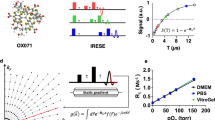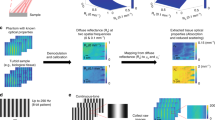Abstract
We have developed nuclear magnetic resonance (NMR) flow imaging techniques to measure fluid flow in a cell-free hollow fiber bioreactor (HFBR). Using 1H NMR we track the motion of protons and obtain velocity distributions as a function of position and time. These measurements enable the visualization of flow patterns needed for module design and for establishing desired operating conditions. Uneven flow in the cell-containing region of an HFBR can result in concentration gradients and uneven cell distribution that may lead to reduced cell viability. Results from this non-invasive method could be used to design more efficient cell bioreac-tors or membrane separation devices.
This is a preview of subscription content, access via your institution
Access options
Subscribe to this journal
Receive 12 print issues and online access
$209.00 per year
only $17.42 per issue
Buy this article
- Purchase on Springer Link
- Instant access to full article PDF
Prices may be subject to local taxes which are calculated during checkout
Similar content being viewed by others
References
Belfort, G. 1989. Membranes and bioreactors: A technical challenge in biotechnology. Biotechnol. Bioengr. 33: 1047–1066.
Knazek, R.A., Gullino, P.M., Kohler, P.O. and Dedrick, R.L. 1972. Cell culture on artificial capillaries: An approach to tissue growth in vitro. Science 178: 65–67.
Starling, E.H. 1896. On the absorption of fluids from the connective tissue spaces. J. Physiol. 19: 312–326.
Moran, P.R. 1982. A flow velocity zeugmatographic interlace for NMR imaging in humans. Magn. Reson. Imag. 1: 197–203.
Gullberg, G.T., Simons, M.A. and Wehrli, F.W. 1988. A mathematical model for signal from spins flowing during the application of spin echo pulse sequences. Mag. Reson. Imag. 6: 437–461.
Edelstein, W.A., Hutchinson, J.M.S., Johnson, G. and Redpath, T. 1980. Spin warp NMR imaging and applications to human whole body imaging. Phys. Med. Biol. 25: 751–765.
Apelblat, A., Katzir-Katchalsky, A. and Silberberg, A. 1974. A mathematical analysis of capillary-tissue fluid exchange. Biorheology. 11: 1–49.
Heath, C.A., Hammer, B.E., Mirer, S.D., Pimbley, J.M. and Belfort, G. 1990. Magnetic resonance imaging and modeling of convec-tive leakage flows in hollow fiber bioreactors. AIChE. J. In press.
Alderman, D.W. and Grant, D.M. 1979. An efficient decoupler coil design which reduces heating in conductive samples. J. Mag. Reson. 36: 447–451.
Fernandez, E.J., Mancuso, A. and Clark, D.S. 1988. NMR spectroscopy studies of hybridoma metabolism in a simple membrane reactor. Biotech. Prog. 4: 173–183.
Gilles, R.J., MacKenzie, N.E. and Dale, B.E. 1989. Analysis of bioreactor performance by nuclear magnetic resonance spectroscopy. Bio/Technology 7: 50–54.
Author information
Authors and Affiliations
Rights and permissions
About this article
Cite this article
Hammer, B., Heath, C., Mirer, S. et al. Quantitative Flow Measurements in Bioreactors by Nuclear Magnetic Resonance Imaging. Nat Biotechnol 8, 327–330 (1990). https://doi.org/10.1038/nbt0490-327
Received:
Accepted:
Issue Date:
DOI: https://doi.org/10.1038/nbt0490-327
This article is cited by
-
Bioreactor design and validation for manufacturing strategies in tissue engineering
Bio-Design and Manufacturing (2022)
-
DPD enables mesoscopic MRI simulation of slow flow
Microfluidics and Nanofluidics (2018)



